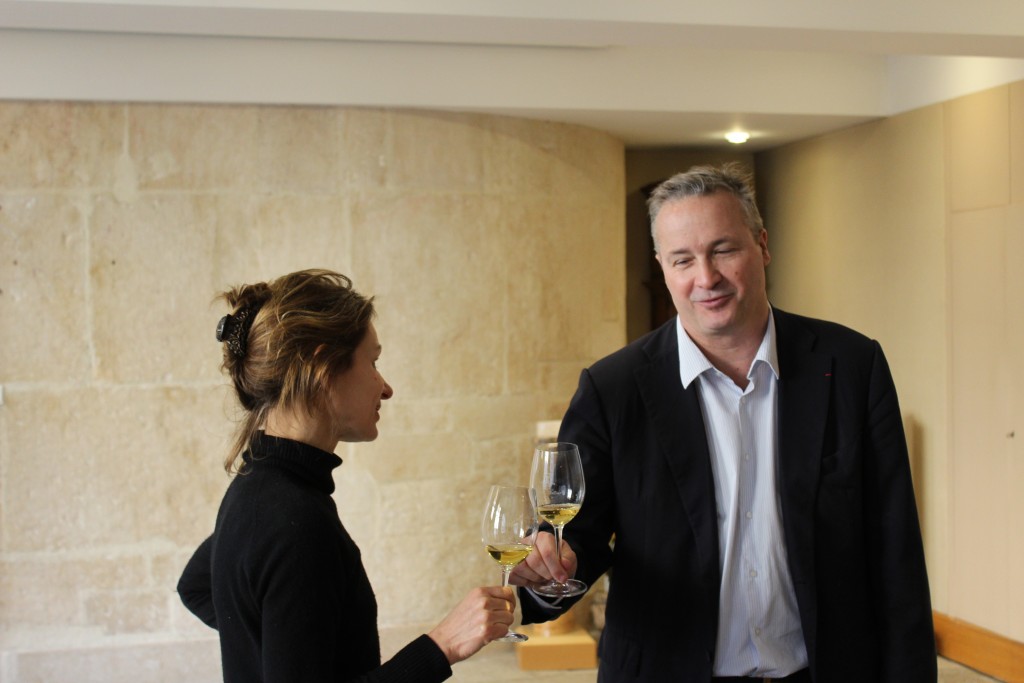Meursault-Blagny 1er cru vertical
Domaine Louis Latour
21 vintages
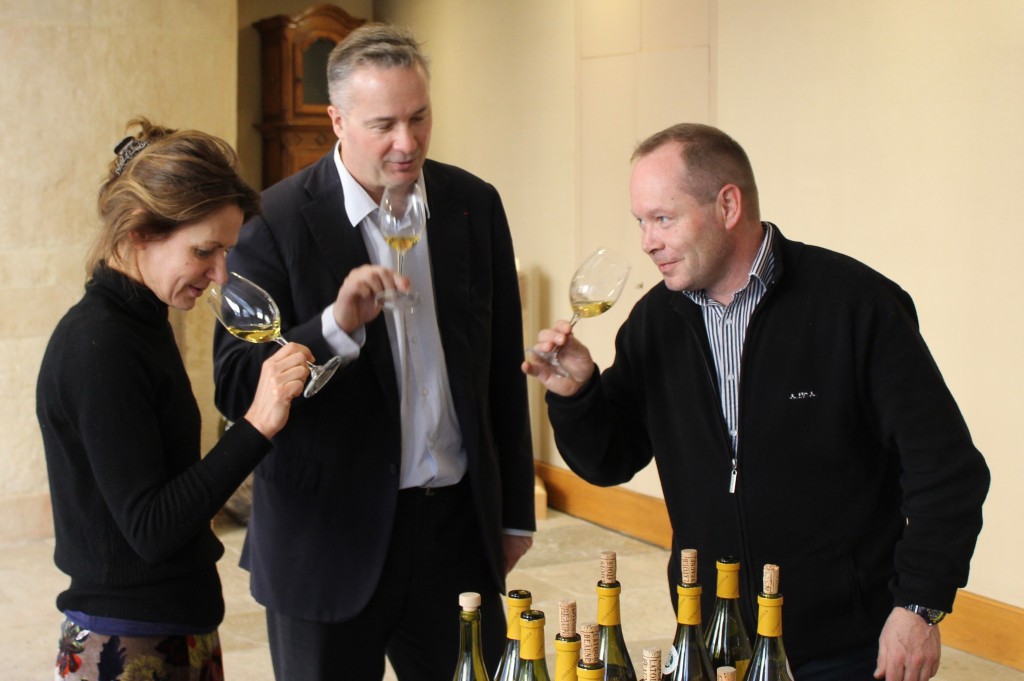
With its fresh acidity, energy and a sense of minerality, does Meursault-Blagny have the winning combination to combat global warming?
On a fine day in February 2019 I met with Louis-Fabrice Latour and his winemaker Jean-Charles Thomas at the elegant family HQ in Beaune to taste a vertical of Meursault, Blagny 1er Cru.
I have recorded their impressions within my tasting notes.
Blagny is a particular favourite of mine. I cycle from Auxey-Duresss most evenings in the early summer after tastings. The peaceful medieval hamlet is surrounded by beautiful vineyards, perhaps most entrancing at sunset is the sweeping premier cru La Piece Sous le Bois which blends into La Jeunelotte beside the hamlet. Under this lies the delightfully named Sous le dos d’Ana. These are classified as Meursault-Blagny, Premier Cru and can be declared separately along with the climats Sous Blagny & Les Ravelles or blended into a single premier cru.
On the south side of the road that winds upwards from Champ Canets the appellation becomes Puligny with the 1er crus Hameau de Blagny, La Garenne and Sous les Puits if planted in Chardonnay. In Blagny you feel a world apart from the grand vineyards of Puligny and Meursault lower on the slope… on the Puligny side a copse creates a physical and sensory divide.. as well as providing a special microclimate. In the middle ages this land belonged to the Cistercian monks and there is still a small chapel here.
We will be considering a white wine, but this can be red territory. As a red wine it becomes Blagny premier cru. These days however there are few vines of Pinot Noir, as white is far more profitable and pinot has been grubbed up.
Maison Louis Latour’s Meursault, 1er Cru Blagny is a blend of the first three Meursault climats mentioned above. They have been buying here for a very long time. Prior to the mid Seventies they often disappeared into a 1er Cru Meursault blend. “Really at that time only Perrières and Genevrières were made separately. People were not that interested in other 1er cru,” remarks Louis-Fabrice. It’s a large and important cuvée for the company. A whole crop is 3000-3500 cases of 12 so around 140 barrels.”
A large part of the vineyard has belonged for the past 200 years to Montlivault, an old aristocratic family distantly related to Louis Latour. The owners are now farming their property themselves – in the process of taking back the land from different vintners. They follow sustainable farming with a lutte raisonée approach.
What about the terroir? Thinnish top soil over Bathonian limestone and as Louis-Fabrice remarks, “It’s well positioned to give higher acidity.”
Here we are at an altitude of 300 up to 360m. The orientation is East with a slight turn to the south in parts. Although it’s high, it catches the sunshine as the Meursault vineyards lie in a sort of shallow amphitheatre.
The altitude is of particular interest with global warming. There is a freshness to the site and the wine from here. This has traditionally be considered quite marginal territory for 1er cru at the top of the slope making quite a high wired, nervous lively wine… a style I particularly like, but without the richness and depth in the mid plate of grander 1er cru.
“In the 1980s we typically had 11% alcohol and TA of 8 in Blagny,” recalls Louis-Fabrice. Clearly viticultural practice has improved and today one expects better ripeness and lower acidity with a much improved balance. Never-the-less the potential of this area for fresh acidity is interesting. With recent warm summers 2015, 2017 and 2018 a natural lively acidity is sort after.
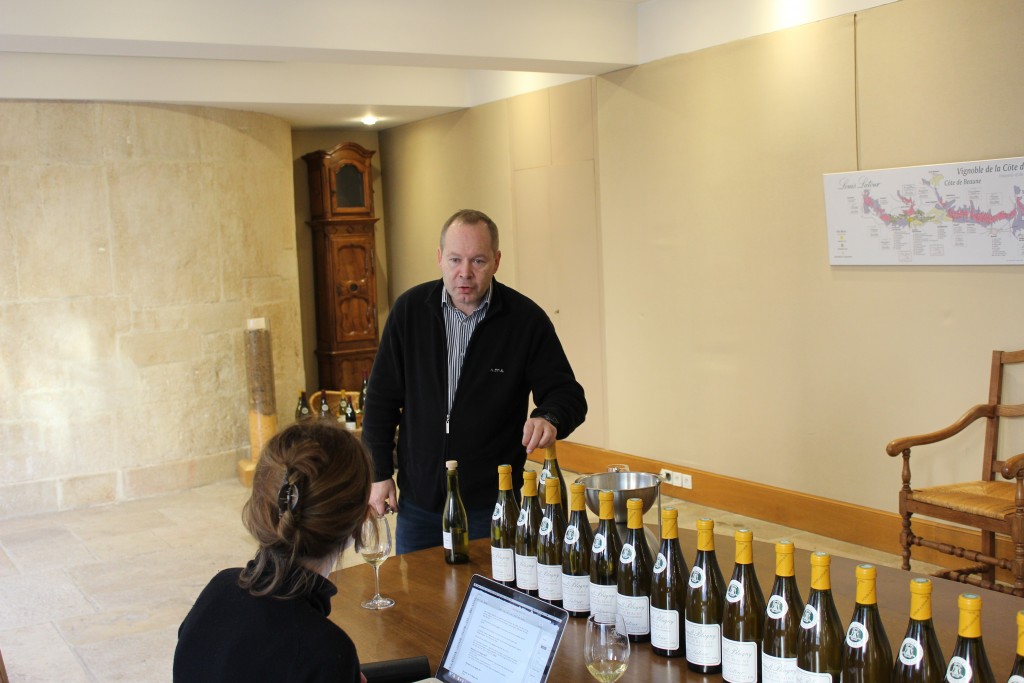
Typical acidity and pH here in the grapes at harvest. Jean-Charles gives provides examples of three types of vintage in Blagny. Figures after MLF.
Cold vintage TA>3.7 and pH 3.2
medium vintage TA 3.5 and pH +/- 3.3
Warm vintage TA<3.2 and pH >3.3
As you can see there’s not a lot of difference in pH. A warm vintage with a post MLF pH of 3.3 is still low, giving good potential to age.
Jean-Claude remarks, “The figures can be quite close despite the vintage – so 2003 and 1996 are very different vintages yet the figures do not reflect the far extremes. Partly because we modify the harvest date of course which lessens the effect, but also because it is quite stable.”
(2003 TA 2.65 & pH 3.59)
(2006 TA 4.31 & pH 3.12)
Louis Latour receive the fruit as must. It is pressed with a pneumatic press by Domaine de Blagny. If fruit is at 25 degrees at harvest they use dry ice spray layered in the press. “This is more for protection against oxidation and not for temperature. However Louis Latour do decide on the date of harvest. “There is no racking,” says Jean-Claude, “We take all the lees. It starts its fermentation in stainless steel and is then moved at a density of 1050 – so about half way through fermentation – into 1/3 new oak. The rest is 1 to 3 year old barrel.”
“We have about 10cm of lees in each barrel in every vintage.”
“Since 2003 we are more attentive to sulphur and CO2. We use less sulphur. We sulphite a 2g at the press.. keep on lees and with attentive topping we need no more additions until after MLF when we add some. It has one racking when we blend the barrels at 8-10 months.”
Louis-Fabrice adds, “We have fewer difficulties with oxidation in Blagny than in any other appellation because of high acidity and the large quantities. Easier to keep the freshness with volume.”
2017 was bottled in November. “Usually we bottle from directly after the vintage – sometimes later in the spring. 2016 was bottled later and generally the cold vintages are later as it depends on the MLF. When the MLF is later, the wine needs more time to marry with the oak afterwards and needs more time on lees. We adapt to the vintage,” says Jean-Charles.
Jean-Charles: “The biggest surprise is the 2003. The effect of a cold vineyard in a hot vintage.”
I agree. 2003 is an extreme example of the advantages of a cooler situation in a hot year, but 2005, 2015 and the current 2018 vintage also demonstrate just how advantageous this site can be as the summers seem more often to be warm and harvests are more often early than late. The low pH and high acidity of 2007 has preserved this vintage from oxidation surprisingly well. However even in a high and cooler location it is still necessary to pick in good time. 2006 was picked a little too late. But the 89, a hot vintage, was still very attractive with just a hint of oxidation on the finish. It was not tired and this is a wine from a hot vintage 30 years ago. Now that’s impressive!
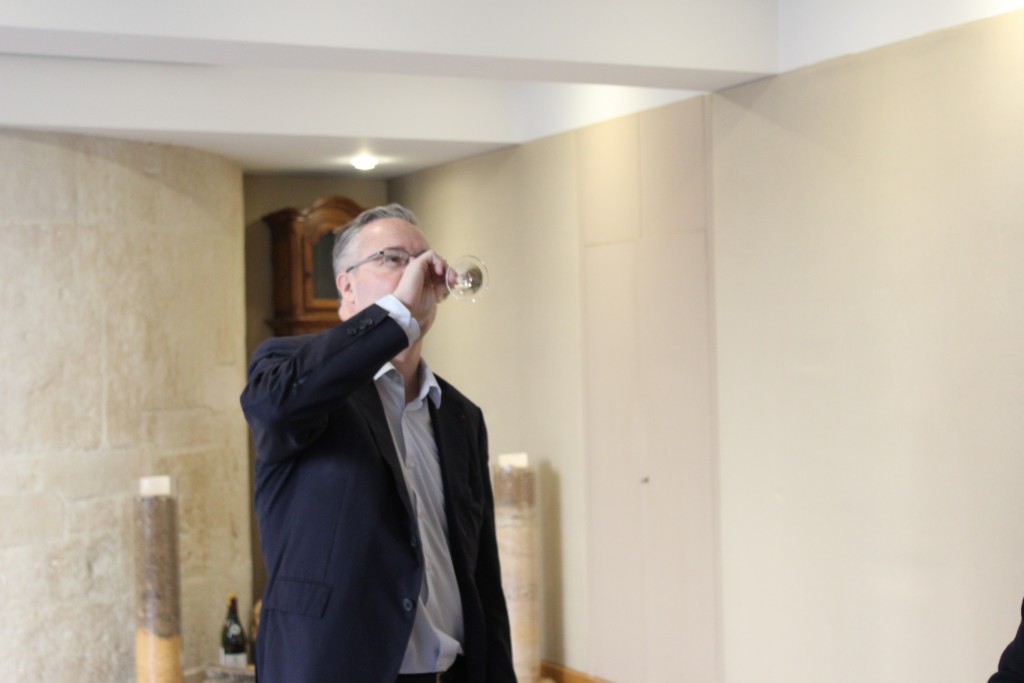
Tasting Notes
Tasted February 2019
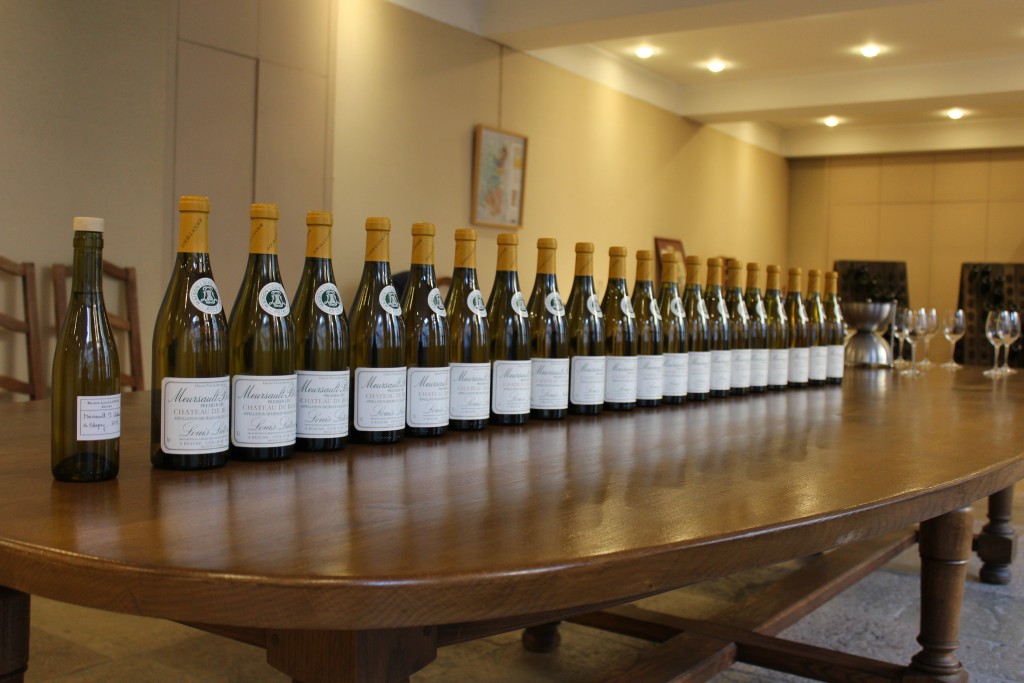
**-***Meursault-Blagny, 1er Cru 2018
This has a rich citrus palate, but firm acidity; ripe with a good cut of minerality. It is powerful. 13.2 alcohol, but not a whit heavy for you feel the warmth the vintage, but it’s very contained. It is quite leesy with marked new oak, but this is not unusual at this point. It transpired the sample was from new oak and given this, it did not overwhelm. You sense the power and richness of the vintage, but it has a really good cut of dry minerality and freshness. Fair to say that in this hot vintage the situation seems to really assist the balance… be it from the acidity or minerality or both. Score 17.85
“Harvest started at end of August, but takes the family 10 days. And they stopped and restarted .. long and slow – one vineyard was blocked. And he has a small team. This year however it was picked before the Corton-Charlemagne which is unusual,” says Louis-Fabrice.
Jean-Charles. “1.2-1.5 malic – very low, but not as low as 2003 when the was zero… yet tastes fresh. 48-50hl/ha… top end of yields.”
(TA 3.4 & pH 3.25)
*Meursault-Blagny, 1er Cru 2017
November bottling. Fruity and expressive aroma. This is lively and juicy. Quite a slim texture. A joyful wine. Still quite a lot of oak showing, but this should mellow. Overt. Just nicely fresh, but sweeter acidity. Softer than many a vintage in this line up, but nicely balanced. It is very fruity on the finish too. A forward vintage for more immediate drinking. From 2020/21 Score 17.5
There was some rain which diluted the acidity. pH 3.4 and TA 3.4 after MLF
(TA 3.43 & pH 3.29)
***Meursault-Blagny, 1er Cru 2016
Elegant note of white flowers. Concentrated. Glassy. Good depth to the palate. Compact energy and dry salty minerality. Savoury and well edged. Excellent example of Blagny. Needs time. From 2023. Top notch. Score 18
“We didn’t get too much frost in Blagny. So we made 38 h/ha. Some of the Puligny was saved by a mist, protected by the rays of sun. While below on the slope in Meursault it suffered burning by frost,” says Jean Charles. “It is dense mineral and has salinity,” says Louis-Fabrice. “The pastry note is the Meursault and hint of nuttiness from the barrels,” adds Jean-Charles.
(TA 3.31 & pH 3.26)
**Meursault-Blagny, 1er Cru 2015
Fruiter than 2016 and also floral, but with slightly exotic flowers. This has an elegant freshness in this warm vintage. Not at all heavy. It has an smooth citrus finish with a hint of minerality at the end… fresh lift after a round middle. An elegant 2015 indeed. On par or a touch better than 2017. Score 17.7. From 2020, but not hurry at all…this will age nicely, but does not demand ageing.
Good example of the higher situation working well.
“2015 was a vintage for vines on the top of the hill Blagny, for Puligny Garenne and for Sous le Puits and the top of St Aubin, while lower vineyards can be heavier.. in Chassagne, Morgeots can be heavy, but Grand Montagne and Caillerets .. here you get the minerality,” says Louis-Fabrice
(TA 3.21 & pH 3.37)
Meursault-Blagny, 1er Cru 2014
Brioche and light lime zest. Not entirely fresh though. It is delicate and pure and straight, rapier, but a bit dry at the end. Another bottle was brighter on the nose. It was not showing as well as expected. I expected more intensity.
“2014 is a mix of 2016 for density and salinity, with the yields and richness of 2015,” says Jean-Charles.
(TA 3.43 & pH 3.37)
*Meursault-Blagny, 1er Cru 2013
Light note of toast on the nose and a herbal leafy aroma. It is light bodied and fresh with a slight bitterness at the end – a pithy note. There is good acidity. Better than 2011 for sure. Actually I liked this more than I expected. Score 17. It is drinking very well now.
“A part was lost to frost and ripened late. Harvested October. Difficult weather rain and cold, especially for the reds,” says Jean-Charles.
“Here the higher place, may make it a little pithy and herbal, but attractive…,” comments Louis-Fabrice. “You see the same flavour in 2007.. we get the bitterness on a lot of 2013s,” he adds.
(TA 3.35 & pH 3.39)
**Meursault-Blagny, 1er Cru 2012
Very distinctive candied lemon aroma. Rich and dense. Much thicker texture. Developing very nicely. Polar opposite to the 2013. Here the acidity cuts well though the oily texture of the palate. This has the body too. Lovely now, but I am not sure how beneficially it will age further..not for 10 years, maybe for up to five. Score 17.70
“Good average for both colours. A good balance of maturity and youth. This is a food wine for me,” says Jean-Charles. “We had high dry extract in 2012, a phenomenon of concentration because of the small crop. Oidium and mostly mildew did a kind of ‘green harvest’ by killing some of the bunches in June, plus a dry and windy summer with a high level of ripeness and acidity (TA 3.69). The wine got a high level of dry extract which is important for the ageing potential.”
(TA 3.69 & pH 3.22)
Meursault-Blagny, 1er Cru 2011
Last good crop before 2017. This is light and thin. It is fresh and pithy and has a salty note at the end. Maybe a little higher in the crop. The 2013 is better than this 2011 and so is the 2007. Score 15.5. Not a lot of benefit in waiting.
“Good an commercial vintage. A good in between vintage. An easy vintage. Now looking a little thin, but most already drunk, says Louis Fabrice.
(TA 3.43 & pH 3.21)
***Meursault-Blagny, 1er Cru 2010
Marzipan aroma both expressive and concentrated with an edge of roasted hazelnuts. This is delicious now. It is energetic. It has edge. Vital wine. Well defined. You can still wait. Still evolving. Excellent. Score 18.25. I would wait another 3-5 years. This is a keeper.
“You have the coolness of the vintage and the effect of the acidity of Blagny with the compact palate,” says Louis-Fabrice.
2010 (TA 3.74 & pH 3.31)
2009 (TA 3.39 & pH 3.31)
2008 (TA 3.79 & pH 3.29)
*Meursault-Blagny, 1er Cru 2007
Actually this has an inciting fresh citrus nose with a touch of new mown hay. This is silkier in texture than I expected. It is fresh elegant and delicate and pure. Lovely now. This a real surprise. It thought it would appear older and leaner. It’s better than expected. Very yellow still as well. Score 17
“The acidity is so high it has resisted oxidation.” says Louis Fabrice. “I am pleasantly surprised.”
“This may be a lighter and lesser vintage, but the low pH has really preserved this wine,” Jean-Charles.
(TA 3.93 & pH 3.21)
Meursault-Blagny, 1er Cru 2006
There is an caramelised orange note on the nose. The palate is a bit better. It is rich… marmite… lacks a bit of acidity even in Blagny. It’s weighty and lacks energy. The second bottle has more of a honeyed note. It is a bit fresher maybe. Still rather toffee-like fruit, but it has more zip. It shows better on the finish… a bit sappy at the end… You can still find enjoyment in this wine with a meal, bearing in mind the vintage conditions, but it will not delight. score 16
“We learnt a lot from 2006 we should have picked before.” Even with the higher places, it is necessary to pick in good time….
***Meursault-Blagny, 1er cru 2005
This has marked freshness on the nose. Lime notes. It is compact and tense and rich. You taste the salty finish. Power and richness and salty. depth of the palate. Excellent. This is drinking well now. But it will continue to age. Revisit in another 5 years…Score 18.25
“A hot and dry vintage … yet shows particularly well. not a vintage universally successful for whites…”
“Being up in the Côte it makes all the difference….” says Jean-Charles.
(TA 3.41 & pH 3.33)
*Meursault-Blagny, 1er Cru 2003
“Care with the temperature of serving…make sure it is cold,” advises Jean-Charles.
This has an undertone of toffee and creme brûlée and yet is much more interesting and fresher than you might expect. So fresh. It has stuffing, but is not too fat either (at 14 degrees!) They have become more focused with age and it has become a less ‘hot’ vintage. I think the ‘minerality’ is helping here. Score 16.75
“The malic acids was zero – never seen this before even in 2018,” says Jean-Charles. It was bottled in June 04… ie early and they were very careful of the CO2 levels at bottling – 1000 to keep freshness and balance and to not have to use too much SO2. No bâtonnage.
“25 hl/ha low yields, low acidity but focused. 14 degrees and a small acidity yet can age,” remarks Louis-Fabrice.
(TA 2.65 & pH 3.59)
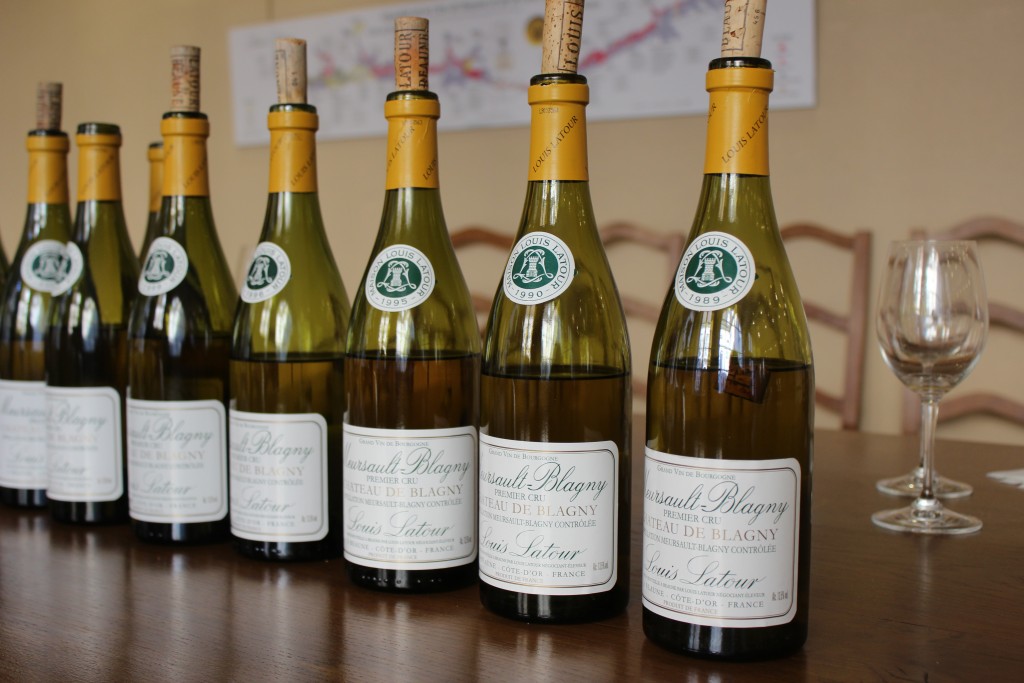
*-**Meursault-Blagny, 1er Cru 2002
A very good vintage with lively acidity. Similar in style in a way to the reds and of similar quality. Not the most lovely summer – but the cool north wind in September helped.
This has a lime freshness and a note of honey. It is elegant with savoury, stoniness, sappy character. It has a light austerity. I like it. Perhaps the finish is not the longest. Modest finish. Still fresh. No hurry, but perhaps will not benefit from further evolution. It has a certain grip. Score 17.65.
“Even in the powerful vintage we feel this austere note” says Louis-Fabrice.
(TA 3.82 & pH 3.21)
Meursault-Blagny, 1er Cru 2001
Wet cold and cloudy year. This is more oxidative… and savoury. Rather flat on the palate. It does lack energy. There is a notable salty savoury note, but lacks flesh and acidity. Score 15
Jean-Charles remarks the flatness and oxidation is due to the rot. The mould is responsible for high levels of quinone, an oxidative component, which makes the wine more susceptible to oxidation.
(TA 3.75 & pH 3.31)
*Meursault-Blagny, 1er Cru 2000
This has a ripe aroma. It is ‘sweet’ juicy and rounded and charming. It is lighter and it has minerality through the palate. This is a good reflection of the terroir. Floral and fruity. A good surprise. Better than expected and therefore … maybe more interesting than the 99 in a way. A bit more concentration. Score 17.
(TA 3.32 & pH 3.22)
Meursault-Blagny, 1er Cru 1999
This has a good intensity of bouquet, there is some tension. It has a lime, lemon quality. It does have surprisingly good energy. Big harvest, so not a great deal of concentration, but so attractive… so very pretty. Score 17.
“It has always been like this a very easy commercial vintage with less power, but lots of fruit, while 2000 is more of a good sups,” says Louis-Fabrice. “They are both very characteristic of vintages in Blagny… very representative.”
(TA 4.03 & pH 3.19)
** Meursault-Blagny, 1er Cru 1996
Somewhat deeper in hue than the ’99, but still relatively pale. Not a hint of oxidation. It is rich and nutty. Full and satisfying on the palate and showing fresh and balancing acidity. It is a mature, but fresh wine. Marmite and almost burnt toast and a touch of honey… an edge of bitterness. Gosh I like it a lot. Score 17.65
(TA 4.31 & pH 3.12)
Meursault-Blagny, 1er Cru 1995
This is much darker in colour than the ’96 and clearly oxidative. Score 15. I didn’t write a note as we were discussing why it was so much more evolved and tired than the 1996. Jean–Charles remarks that the ’95 had mould which gave attractive roundness. Lacked health.. some mould (botrytis) and this gave glycerol with an accompanying richness, and so the wine showed well to begin with, but became oxidative more quickly.
(TA 3.74 & pH 3.29)
**Meursault-Blagny, 1er Cru 1990
Honey on the nose. It is powerful and intense. It is compact and has edge and freshness and at the end a puff of chalk. Large crop… but doesn’t show it. How impressive. I really enjoyed this wine. Score 17.75
“Blagny is full of respect for the vintage. The 90 is compact and full and the 89 is richer and softer,” says Louis-Fabrice.
(TA 3.60 & pH 3.16)
Meursault-Blagny, 1er Cru 1989
The is richer, but less intense on the nose than 90. Full, rich and generous on the palate..fuller than the 90 but also much less energetic and just a touch oxidative on the finish. Given it was a hot year, the wine it still attractive. You would expect it to be tired at this point for a warm vintage, but it is holding up. Drink and enjoy. Score 16.5.
(TA 3.65 & pH 3.32)
